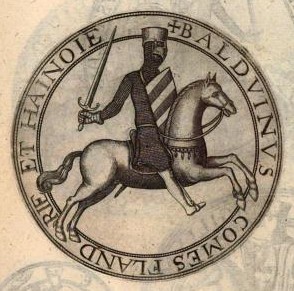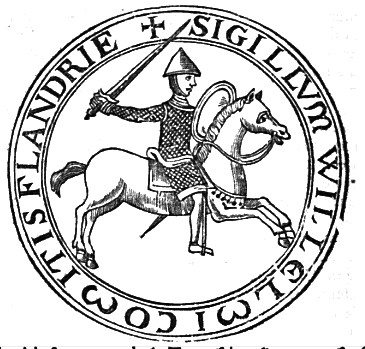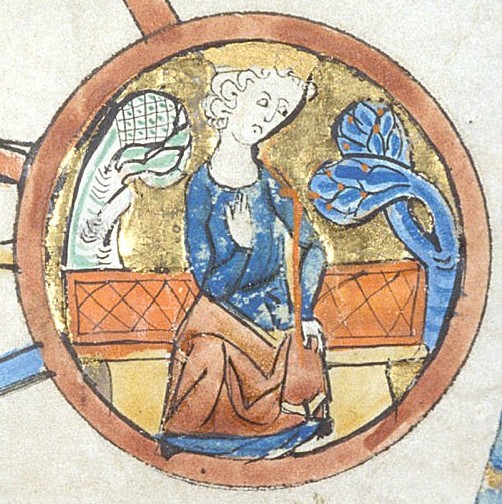|
Thierry Of Alsace
Theoderic (, , ; – 17 January 1168), commonly known as Thierry of Alsace, was the fifteenth count of Flanders from 1128 to 1168. With a record of four campaigns in the Levant and Africa (including participation in the Second Crusade, the failed 1157–1158 siege of the Syrian city Shaizar, and the 1164 invasion of Egypt), he had a rare and distinguished record of commitment to crusading. Countship Theoderic was the youngest son of Duke Theoderic II of Lorraine and Gertrude, daughter of Count Robert I of Flanders. After the murder of his cousin, Charles the Good, in 1127, Theoderic claimed the County of Flanders, but another cousin, William Clito, became count instead with the support of King Louis VI of France. William's politics and attitude towards the autonomy of Flanders made him unpopular, and by the end of the year Bruges, Ghent, Lille, and Saint-Omer recognized Theoderic as a rival count. Theoderic's supporters came from the Imperial faction of Flanders. Louis VI ... [...More Info...] [...Related Items...] OR: [Wikipedia] [Google] [Baidu] |
Count Of Flanders
The count of Flanders was the ruler or sub-ruler of the county of Flanders, beginning in the 9th century. Later, the title would be held for a time, by the rulers of the Holy Roman Empire and Spain. During the French Revolution, in 1790, the county of Flanders was annexed to France and ceased to exist. In the 19th century, the title was appropriated by Belgium and granted twice to younger sons of Belgian kings. The most recent holder died in 1983. In 862 Baldwin I was appointed as the first Margrave of Flanders by Charles the Bald, King Charles II. It was a military appointment, responsible for repelling the Viking raids from the coast of Francia. The title of margrave (or marquis) evolved into that of count. Arnulf I, Count of Flanders, Arnulf I was the first to name himself as count, by the Grace of God. The title of margrave largely fell out of use by the 12th century. Since then, the rulers of Flanders have only been referred to as counts. The counts of Flanders enlarged t ... [...More Info...] [...Related Items...] OR: [Wikipedia] [Google] [Baidu] |
Crusader Invasions Of Egypt
Egypt was repeatedly invaded from 1163 to 1169 by King Amalric of Jerusalem, who wished to strengthen its position in the Levant by taking advantage of the weakness of the Fatimid Caliphate. The invasions began as part of a succession crisis in the caliphate, which began to crumble under the pressure of Muslim Syria ruled by the Zengids and the Christian Crusader states. While one side called for help from the emir of Syria, Nur ad-Din Zengi, the other called for Crusader assistance. As the war progressed, however, it became a war of conquest. A number of Syrian campaigns into Egypt were stopped short of total victory by the aggressive campaigning of King Amalric. Even so, the Crusaders generally speaking did not have things go their way, despite several sackings. A combined Byzantine–Crusader siege of Damietta failed in 1169, the same year that Saladin took power in Egypt as vizier. In 1171, Saladin became sultan of Egypt and the crusaders thereafter turned their attention to ... [...More Info...] [...Related Items...] OR: [Wikipedia] [Google] [Baidu] |
Battle Of Axspoele
The Battle of Axspoele (sometimes Axpoele or Thielt) took place on 21 June 1128 on the Heerlijkheid, landed estate of the lords of Axpoele in the County of Flanders between William Clito and Thierry, Count of Flanders, Thierry of Alsace. The two men were rivals for the title of Count of Flanders. William had been appointed to the title by Louis VI of France following the 1127 murder of Charles the Good but Thierry, cousin of Charles, had the support of Henry I of England. In 1128, Thierry secured the support of a number of Flemish cities, although most of the nobility supported William. Thierry led a force of 300 mounted Man-at-arms, men-at-arms and 1,500 Infantry in the Middle Ages, infantrymen to Axspoele on 19 June to lay siege to a castle held by one of William's supporters. William was aware of Thierry's movements and moved with a force of 450 men-at-arms to raise the siege. On arrival he recognized that most of Thierry's army was infantry and decided to give battle. He positi ... [...More Info...] [...Related Items...] OR: [Wikipedia] [Google] [Baidu] |
Henry I Of England
Henry I ( – 1 December 1135), also known as Henry Beauclerc, was King of England from 1100 to his death in 1135. He was the fourth son of William the Conqueror and was educated in Latin and the liberal arts. On William's death in 1087, Henry's elder brothers Robert Curthose and William Rufus inherited Duchy of Normandy, Normandy and England, respectively; Henry was left landless. He purchased the County of Cotentin in western Normandy from Robert, but his brothers deposed him in 1091. He gradually rebuilt his power base in the Cotentin and allied himself with William Rufus against Robert. Present in England with his brother William when William died in a hunting accident, Henry seized the English throne, promising at his coronation to correct many of William's less popular policies. He married Matilda of Scotland and they had two surviving children, Empress Matilda and William Adelin; he also had many illegitimate children by his numerous mistresses. Robert, who invaded from ... [...More Info...] [...Related Items...] OR: [Wikipedia] [Google] [Baidu] |
Archbishop Of Reims
The Archdiocese of Reims or Rheims (; French language, French: ''Archidiocèse de Reims'') is a Latin Church ecclesiastic territory or archdiocese of the Catholic Church in France. Erected as a diocese around 250 by Sixtus of Reims, the diocese was elevated to an archdiocese around 750. The archbishop received the title "primate of Gallia Belgica" in 1089. In 1023, Archbishop Ebles I of Roucy, Ebles acquired the Countship of Reims, making him a prince-bishop; it became a duchy and a French peerage, peerage between 1060 and 1170. The archdiocese comprises the ''arrondissement in France, arrondissement'' of Reims and the département of Ardennes (department), Ardennes while the province comprises the former ''Regions of France, région'' of Champagne-Ardenne. The suffragan dioceses in the ecclesiastical province of Reims are Roman Catholic Diocese of Amiens, Amiens; Roman Catholic Diocese of Beauvais, Beauvais, Noyon, and Senlis; Diocese of Châlons, Châlons; Roman Catholic Dioces ... [...More Info...] [...Related Items...] OR: [Wikipedia] [Google] [Baidu] |
Holy Roman Empire
The Holy Roman Empire, also known as the Holy Roman Empire of the German Nation after 1512, was a polity in Central and Western Europe, usually headed by the Holy Roman Emperor. It developed in the Early Middle Ages, and lasted for a millennium until its Dissolution of the Holy Roman Empire, dissolution in 1806 during the Napoleonic Wars. For most of its history the Empire comprised the entirety of the modern countries of Germany, Czechia, Austria, the Netherlands, Belgium, Switzerland, Slovenia, and Luxembourg, most of north-central Italy, and large parts of modern-day east France and west Poland. On 25 December 800, Pope Leo III crowned the Frankish king Charlemagne Roman emperor, reviving the title more than three centuries after the fall of the Western Roman Empire in 476. The title lapsed in 924, but was revived in 962 when Otto I, OttoI was crowned emperor by Pope John XII, as Charlemagne's and the Carolingian Empire's successor. From 962 until the 12th century, the empire ... [...More Info...] [...Related Items...] OR: [Wikipedia] [Google] [Baidu] |
Saint-Omer
Saint-Omer (; ; Picard: ''Saint-Onmé'') is a commune and sub-prefecture of the Pas-de-Calais department in France. It is west-northwest of Lille on the railway to Calais, and is located in the Artois province. The town is named after Saint Audomar, who brought Christianity to the area. The canalised section of the river Aa begins at Saint-Omer, reaching the North Sea at Gravelines in northern France. Below its walls, the Aa connects with the Neufossé Canal, which ends at the river Lys. History Saint-Omer first appeared in the writings during the 7th century under the name of Sithiu (Sithieu or Sitdiu), around the Saint-Bertin abbey founded on the initiative of Audomar, (Odemaars or Omer). Omer, bishop of Thérouanne, in the 7th century established the Abbey of Saint Bertin, from which that of Notre-Dame was an offshoot. Rivalry and dissension, which lasted till the French Revolution, soon sprang up between the two monasteries, becoming especially virulent when ... [...More Info...] [...Related Items...] OR: [Wikipedia] [Google] [Baidu] |
Lille
Lille (, ; ; ; ; ) is a city in the northern part of France, within French Flanders. Positioned along the Deûle river, near France's border with Belgium, it is the capital of the Hauts-de-France Regions of France, region, the Prefectures in France, prefecture of the Nord (French department), Nord Departments of France, department, and the main city of the Métropole Européenne de Lille, European Metropolis of Lille. The city of Lille proper had a population of 236,234 in 2020 within its small municipal territory of , but together with its French suburbs and exurbs the Lille metropolitan area (French part only), which extends over , had a population of 1,515,061 that same year (January 2020 census), the fourth most populated in France after Paris, Lyon, and Marseille. The city of Lille and 94 suburban French municipalities have formed since 2015 the Métropole Européenne de Lille, European Metropolis of Lille, an Indirect election, indirectly elected Métropole, metropolitan ... [...More Info...] [...Related Items...] OR: [Wikipedia] [Google] [Baidu] |
Ghent
Ghent ( ; ; historically known as ''Gaunt'' in English) is a City status in Belgium, city and a Municipalities of Belgium, municipality in the Flemish Region of Belgium. It is the capital and largest city of the Provinces of Belgium, province of East Flanders, and the third largest in the country, after Brussels and Antwerp. It is a Port of Ghent, port and Ghent University, university city. The city originally started as a settlement at the confluence of the Rivers Scheldt and Leie. In the Late Middle Ages Ghent became one of the largest and richest cities of northern Europe, with some 50,000 people in 1300. After the late 16th century Ghent became a less important city, resulting in an extremely well-preserved historic centre, that now makes Ghent an important destination of tourism. The municipality comprises the city of Ghent proper and the surrounding suburbs of Afsnee, Desteldonk, Drongen, Gentbrugge, Ledeberg, Mariakerke, East Flanders, Mariakerke, Mendonk, Oostakker, S ... [...More Info...] [...Related Items...] OR: [Wikipedia] [Google] [Baidu] |
Bruges
Bruges ( , ; ; ) is the capital and largest city of the province of West Flanders, in the Flemish Region of Belgium. It is in the northwest of the country, and is the sixth most populous city in the country. The area of the whole city amounts to more than 14,099 hectares (140.99 km2; 54.44 sq. miles), including 1,075 hectares off the coast, at Zeebrugge (from , meaning 'Bruges by the Sea'). The historic city center is a prominent World Heritage Site of UNESCO. It is oval and about 430 hectares in size. The city's total population is 117,073 (1 January 2008),Statistics Belgium; ''Population de droit par commune au 1 janvier 2008'' (excel-file) Population of all municipalities in Belgium, as of 1 January 2008. Retrieved on 19 October 2008. of who ... [...More Info...] [...Related Items...] OR: [Wikipedia] [Google] [Baidu] |
Louis VI Of France
Louis VI (1 December 1081 – 1 August 1137), called the Fat () or the Fighter (), was List of French monarchs, King of the Franks from 1108 to 1137. Like his father Philip I of France, Philip I, Louis made a lasting contribution to centralizing the institutions of royal power. He spent much of his twenty-nine-year reign fighting either the "Robber baron (feudalism), robber barons" who plagued the Ile de France or Henry I of England for his continental possession of Normandy. Nonetheless, Louis VI managed to reinforce his power considerably, often resorting to force to bring lawless knights to justice, and was the first member of the house of Capet to issue ordonnances applying to the whole of the kingdom of France. Louis was a warrior-king, but by his forties his weight had become so great that it was increasingly difficult for him to lead in the field (hence the epithet ). Details about his life and person are preserved in the , a panegyric composed by his loyal advisor, Suger, ... [...More Info...] [...Related Items...] OR: [Wikipedia] [Google] [Baidu] |
William Clito
William Clito (25 October 1102 – 28 July 1128) was a member of the House of Normandy who ruled the County of Flanders from 1127 until his death and unsuccessfully claimed the Duchy of Normandy. As the son of Robert Curthose, the eldest son of William the Conqueror, William Clito was seen as a candidate to succeed his uncle King Henry I of England. Henry viewed him as a rival, however, and William allied himself with King Louis VI of France. Louis installed him as the new count of Flanders upon the assassination of Charles the Good, but the Flemings soon revolted and William died in the struggle against another claimant to Flanders, Thierry of Alsace. Youth William was the son of Duke Robert Curthose of Normandy and Sibylla of Conversano. His father was the first son of King William the Conqueror of England. His nickname ''Clito'' was a Medieval Latin term equivalent to the Anglo-Saxon ''" Aetheling"'' and its Latinized form ''"Adelinus"'' (used to refer to his first cou ... [...More Info...] [...Related Items...] OR: [Wikipedia] [Google] [Baidu] |





